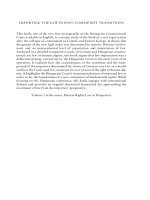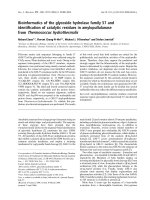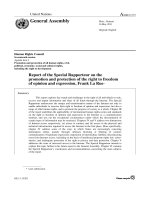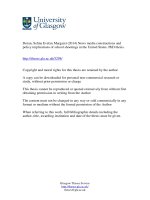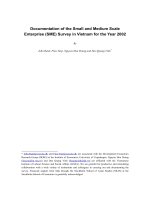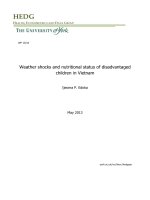The right to self rule and large scale of agricultural investment in gambella peoples national regional state
Bạn đang xem bản rút gọn của tài liệu. Xem và tải ngay bản đầy đủ của tài liệu tại đây (494.19 KB, 111 trang )
Addis Ababa University
College of Law and Governance Study
Center for Federal Study
“The Right to Self Rule and Large Scale of Agricultural Investment in Gambella
Peoples National Regional State”
By: Wichduel Keat Kueth
Submitted To: Addis Ababa University, Center for Federal Study
Supervisor: Mr Abay Yimer
June, 2017
Addis Ababa, Ethiopia
i
Addis Ababa University
College of Law and Governance Study
Center for Federal study
“The Right to Self Rule and Large Scale of Agricultural Investment in Gambella
National Regional State”
By Wichduel Keat Kueth
A thesis submitted to Addis Ababa University college of Law and Governance,
Center for Federal Study in the partial fulfillment of the requirement for the
awards of the Master degree of Art in Federalism and Governance study
Supervisor: Abay Yimer
June, 2017
Addis Ababa-Ethiopia
ii
Addis Ababa University
College of Law and Governance Study
Center for Federal study
“The Right to Self Rule and Large Scale of Agricultural Investment in Gambella
Peoples National Regional State”
By Wichduel Keat Kueth
A thesis submitted to Addis Ababa University college of Law and Governance,
Center for Federal Study in the partial fulfillment of the requirement for the
awards of the Master degree of Art in Federalism and Governance study
Approved by examining board:
Supervisor: Mr Abay Yimer
Signature
_______________
Date
_____________
Examiners: Dr Seyoum Mesfin ______________
______________
Dr Mohammad Dejen _____________
______________
June, 2017
Addis Ababa, Ethiopia
iii
Dedication
The dedication for this research paper goes to my lovely brother Kim Keat Kueth
(Simon) who remain in my heart but his untimely death separate us!! You are in
our prayer every day brother.
iv
Declaration
I undersigned, declare that this research is my original work and has not been presented for a
degree in any other college or university and that all sources of material used for this research
have been duly acknowledged.
Wichduel Keat Kueth
June, 2017
This research is submitted for examination with my approval as a supervisor of the candidate
______________________________________________________________________________
Abay Yimer
June, 2017
v
Acknowledgments
First of all, my sincere thanks go to my supervisor, Mr Abay Yimer for his guidance and vital
comments in all stages of the research project. I am also grateful to Addis Ababa University,
Center for Federal Study for the scholarship extended to me in the course of my study and
writing this thesis.
Secondly, I would like to take opportunity to thank the Center for Federal Studies for such a
wonderful learning environment. I also sincerely appreciate the whole staff at the center for their
diligent work ethic and immense assistance.
Thirdly, I would like to thank my guide and interpreters who helped me during my field work
Mr. Penya and Ato Duop. This research paper would not have been possible without their
assistance.
Fourth, this research would not have been successful without the cooperation of my informants
in the community, who provided me all the information I sought and I am truly grateful for that.
My special thanks also goes to all key informants in local people in Biliemkun, Tandar, Thenyi,
Perbongo, Gelishi and Kabo, management employees of investment companies, the Lare, Abobo
and Godere Administrative weredas Local Government Officials and GPNRSs
Investment
Agency, Gambella Peoples Regional Council and Bureau of Agriculture and Natural Resource. I
am also thankful for the large scale of agricultural investment companies who allowed me to
inspect their investment land.
Finally, I would like to thank my parents, My Mom Ms Buk Rom, Brother Mr Bol Keat, my
young little brother Gambel Keat and my twin’s sisters Nyamac Keat and Nyanciok Keat for
their unwavering praying, love and support during my study and all my life.
Above all, many Thanks go to Almighty God in the Heaven.
i
List of Abbreviations and Acronym
ADLI
Agricultural Development led Industrialization
AISD
Agricultural Investment Support Directorate
BoARD
Bureau of Agriculture and Rural Development
BoANR
Bureau of Agriculture and Natural Resources
CSA
Central Statistical Agency
EIA
Environmental Impact Assessment
EPA
Environmental Protection Agency
EPRDF
Ethiopian People’s Revolutionary Democratic Front
EWCA
Ethiopian Wild Life and Conservation Authority
FAO
Forest and Agriculture Organization
FDRE
Federal Democratic Republic of Ethiopia
FDI
Foreign Direct Investment
GDP
Growth Domestic Products
GDP1
Growth and Transformation Plan 1
GOE
Government of Ethiopia
GRS
Gambella Regional State
GNRS
Gambella National Regional State
GPNRS
Gambella Peoples National Regional State
Ha
Hectare
ii
IFAD
International Fund for Agriculture Development
LSAI
Large Scale of Agriculture Investment
LSLA
Large Scale Land Acquisition
LSALA
Large Scale Agriculture Land Acquisitions
LSLT/I
Large scale land Transfer/Investment
Masl
Meters above Sea Level
MNC
Multi National Company
MoANR
Ministry of Agriculture and Natural Resources
MoARD
Ministry of Agriculture and Rural Development
MoFED
Ministry of Finance and Economic Development
NGO
Non-Governmental Organization
PASDEP
Plan for Accelerated and Sustained Development to End Poverty
SDPRP
Sustainable Development and Poverty Reduction Program
SNNPR
Southern Nations, Nationalities and Peoples
UN
United Nation
USD
United States Dollars
iii
Table of Contents
Acknowledgments............................................................................................................................ i
List of Abbreviations and Acronym ............................................................................................... ii
Table of Contents........................................................................................................................... iv
List of Tables ............................................................................................................................... viii
Figures.......................................................................................................................................... viii
Abstract .......................................................................................................................................... ix
Chapter One .................................................................................................................................... 1
1 Introduction.................................................................................................................................. 1
1.1 Background of the study ........................................................................................................... 3
1.2. Statement of the problem .................................................................................................................. 5
1.3. Research Questions........................................................................................................................... 7
1.4. Objective of the study ........................................................................................................................ 8
1.4.1. General objectives....................................................................................................................... 8
1.4.2. Specific objective....................................................................................................................... 8
1.5. Significance of the study.................................................................................................................... 9
1.6.Scope of the Study .............................................................................................................................. 9
1.7. Structure of the study ....................................................................................................................... 10
Chapter Two…………………………………………………………………………………………………………………………………………13
Review of Literature……………………………………………………………………………………………………………………………..13
2.1. The Right to Self Rule and Large Scale of Agricultural investment………………………….........13
iv
2.1.1. The constitutional Provision on the right to Self-Rule and Large Scale of Agriculture Investment 14
2.2. Perspectives of the Large Scale of Agricultural Investment ............................................................ 15
2.3 Large Scale of Agriculture Investment and Land Acquisitions ........................................................ 17
2.4 Limitations of the Large scale Agriculture Land deals..................................................................... 18
Chapter Three................................................................................................................................ 21
3.1 Ethiopia’s Agriculture Sector: An overview..................................................................................... 21
3.2 Rural Land Administration in Ethiopia: Land Tenure ...................................................................... 22
3.3. Large Scale Agricultural Land Transfer in Ethiopia........................................................................ 25
3.3.1. Investment Legislations and Institutional Arrangements.......................................................... 26
3.3.2. Large Scale of Agriculture Investment in Ethiopia................................................................... 30
3.3.2.1 Large scale of Agriculture Investment in Gambella National Regional State ........................ 34
3.3.3. Duties of Large Scale Agriculture Investors ............................................................................. 35
Chapter Four ................................................................................................................................. 38
Research Method .......................................................................................................................... 38
4.1 Study Area Description..................................................................................................................... 38
4.1.1 The Geographical Location of Abobo, Lare and Godere Administrative Weredas ................... 40
4.2. Methods and Instruments used for Data Collection......................................................................... 43
4.3. Methods of Data Analysis................................................................................................................ 44
4.4. Limitations of the Study................................................................................................................... 44
4.5. Ethical Considerations ..................................................................................................................... 45
v
Chapter Five.................................................................................................................................. 46
Data Analyses and Interpretation.................................................................................................. 46
5.1. The institutional and legal protection mechanisms used in place to secure the right to Self-Rule
during transfer of agricultural land to investors in Gambella National Regional State .......................... 46
5.1.1The institutional and legal protection of land Governance and Land-Related Resources .......... 46
5.2. The Extent of participation of local communities during land acquisition transfer to Large Scale
agriculture Investment ............................................................................................................................ 50
5.2.1 Large Scale of Agriculture Investment Transfer in Gambella National Regional State ............ 50
5.2.2. The Process of Large Scale Agriculture and its Relation to Local Community farming.......... 50
5.2.3. Transparency of the Large Scale Land Acquisitions Deals ...................................................... 52
5.2.4. The issue of compensation for the loosed land ......................................................................... 53
5.3. The extents of the benefits/changes brought by large scale of agricultural land investment to the
local communities ................................................................................................................................... 54
5.3.1. Social change/benefits brought of Large Scale agriculture Land Transfer in Gambella National
Regional State ..................................................................................................................................... 56
5.3.2 Economic Benefits/change of Large Scale Agriculture Land Transfer in Gambella National
Regional State ..................................................................................................................................... 62
5.4. The mechanisms used in response of shortage of land taken from the farmers used for large scale
of agricultural land investment to recover the livelihood of local communities..................................... 69
Chapter Six.................................................................................................................................... 73
Findings and Recommendations ................................................................................................... 73
6.1 Findings............................................................................................................................................. 73
6.2. The research Recommendations ...................................................................................................... 76
6.2.1. Suggestions for Various Stakeholders……………………………………………...........................76
vi
6.2.1.1. For the Government………………………………………………………………………………76
6.2.1.2. For LargeScaleofAgricultureInvestors……………………………………………………………77
6.2.1.3.ForCivilSocietyOrganizationandActivists……………………………………………………………………………….77
References......................................................................................Error! Bookmark not defined.
Legislations
Appendix 1
Appendix 2
vii
List of Tables
Table 1. Distribution of Large scale agriculture Investment in GNRS......................................... 35
Table 2. Background of the Thesis (Research participant)........................................................... 43
Figures
Figure1, the administrative map of Gambella Peoples National Regional State .......................... 39
viii
Abstract
This study attempts to examine/asses the right to self-rule and large scale of agriculture
investment in Gambella National Regional State western Ethiopia, based on the assessment on
the self-rule, socio-economic and environmental effects of large scale agriculture land
investment/transfer on local people’s livelihoods. The analysis of this research followed
descriptive qualitative research approach. The primary data was collected through key informant
interviews, focus group discussions and direct observation by the author. To complement the
primary data, secondary data which the researcher found from government legal documents and
various published and unpublished sources were used. After analyzing the data collected, the
study found that the transfer of large scale agriculture investment on land to domestic and
foreign investors have brought no significant social benefits to the local communities, political
economic as measured by the level and type of technological transfer, creation of employment
opportunities and level of food crop production. However, some Large Scale Agricultural
Investment to investors has helped improve infrastructure. The study also found that the
investment has negative effects on the self-rule, local small scale farming or economies in terms
of loss of crop land, grazing land, grass land, firewood and water resources; these have
negatively affected local agrarian economies and animal rearing livelihoods. Moreover, the
investments have negative environmental effects on the biodiversity resource as observed by the
scale of clearing of the indigenous vegetation cover, damage on wildlife, depletion of water
resources, exposed the land to soil erosion and soil degradation. Besides these issues, this study
identified the coping strategies pursued by local communities in response to the effects of the
transfer of the large scale agriculture of their land and natural resources ownership to the
investors. These strategies include changing land use, sharecropping, tenant farming, changing
occupation and mobility or migration patterns. Lastly, the research suggests/recommend some
ideas for policy makers which emerged from the field study. They include suggestions for the
government, investors, stakeholders and civic societies.
Key Terms: self-rule, Large Scale of Agriculture Investment (LSAI), Local Community,
agribusiness Investment, Socio-economic effects, constitution, Coping Strategy
ix
Chapter One
Introduction
After defeating the Derge1 regime in 1991, Ethiopia established a federal system that is
organized on the basis of the right to ethnic communities to the right to self-rule. The recognition
of the nations, nationalities and peoples the right to self-rule has become imperative to establish
peace and democracy in the country and has demanded the restructure of the Ethiopian map on
the basis of the new political structure that guarantees the maintenances and promotion of
distinctive ethno-cultural identities while building a common federal polity that allow each to
pursue their common make up. As ethnic federalism institutionalize the right to self-rule and
shared rule ,it empowered the regional state to administer rural land and other natural resources
left to regional states of Ethiopian ethnic territorial communities by guarantying their
representation and participation in governances process, by which it is viable constituted means
to democracy.
Meanwhile, under the issue of land or other natural resources administration, the federal
constitution of Ethiopia, both the federal and regional state “shall jointly levy and collect taxes
on incomes derived from large scale mining and all petroleum and, gas operations and royalties
on such operations”(,Article, 98:3).2This is means to concurrent power to both the federal and
regional states. According to 1995 constitution, in case of emergence of other revenue sources or
undesignated powers of taxation, it is stipulated that, “the House of Federation and the House of
Peoples Representatives shall, in a joint session, determine by a two thirds majority vote on the
exercises on powers of taxation which has not been specifically provided in the constitution”
(Article, 99). It seems contradicted with Article 51:2 by which it states, “All powers not given
expressly to the Federal alone or concurrently to the Federal and Regional States are reserved to
the States”.
1
The term Derg is Geez word means committee or council of army that rule Ethiopia from 1974-1991
2
See more on the 1995 Federal Democratic Republic of Ethiopia constitution
1
Furthermore, it could be argued that, the FDRE constitution legal frame work to some extent
recognizes economic self-reliance to nations, nationalities and peoples of Ethiopia. In addition to
this, the local communities/indigenous peoples demand the right to self-rule in order to preserve
their own political and socio-cultural rights. Particularly as Thornberry (2002),3 asserted states
where majorities do not only control the politics and economy but also impose their culture over
the rest, demand of socio-economic and culture goes in hand with the right of minorities to selfdetermination to that of politics.
Therefore, GPNRS4, one of the members of the federation founded in 1995, this determined the
necessary features of the right to self-rule. The region composed of three nationality
administrative zones and 12 administrative weredas namely the Nuer Nationality Zone, the
Anywaa Nationality Zone and the Majang Nationality Zone (GPNRS, office of chief
administrator, 2016/7). They inhibit in what is Gambella National Regional State, 12 wereda,
one special wereda and one city administration or (hereafter district): Jikouw, Lare, Wanthoa,
Makuey and Akobo wereda in the Nuer Nationality Zone, Gambella zuria wereda, Abobo, Gog,
Jor and Dimma wereda in Anywaa Nationality Zone and also Godere and Mengeshi wereda in
Majang Nationality Zone. The area of the region is 29,783 square kilometers with estimated
population of over 409,096 inhabitants (CSA 2013/14 abstract). Within the region, Gambella
National Park covers approximately 5061 square kilometers (19.6%) of the Region’s territory.
The topography of the region is divided in to two broad classes, which are the lower piedmonts
between 500 to 1900 masl and the flood plains of below 500m contours. The (Ker) Baro, Gilo,
Akobo and Alwero are the main rivers crossing the Gambella National Regional State.
The City administration of Gambella served as the seat of five different nations, nationalities and
peoples of the Region including other Ethiopian ethnic group. To mention few of them, the
Oromo, Kambata, Tigrayan, Welaita, Amhara by which the local indigenes people used to call
3
4
Thornberry, P., (2002), Indigenous peoples and Human Rights, Manchester: Manchester University Press.
GPNRS refers to Gambella People National Regional State
2
them high landers (Buony)5etc that constituted half of the population to the region dominated the
economic sector. These peoples largely live in Gambella city, Abobo, Itang, Dimma, Godere and
Gog wereda. The city administration of Gambella and Itang special wereda, responsible for
Gambella National Regional state administrative Council. Traditionally the people of Gambella
were described as egalitarian society with political system based on meritocracy and
gerontocracy (Evans-Pritchard 1940a cited in Messay, 2015). The Nuers peoples practice
transhumance pastoralist steadily changing toward agro-pastoralist (Stuart: 1971 cited in Dereje
2006). According to the 2007 Population and Housing Census ethnic groups in Gambella
Regional State, comprises the Nuer 46.7%, Anywaa 26%, Majang 0.6 and others 1% formed the
total indigenous population (CSA: 2007).
1.1 Background of the study
When the FDRE constitution of 1995 comes in to force, the country created federal state that
devised the coming together state (FDRE constitution, 1995). The political system recognized
the right to self-administration, federalism and legal pluralism as a solution of the past unjust
relationship between different ethnic groups (Getachew A, 2011).6 The right to self-rule and the
just distribution of natural resource prevail in the new constitution of 1995 that reveal among the
regional state have generated power sharing. Its justification is the new federal pie which opened
a new political space and development discourse (Assefa Fiseah, 2016, Dereje 2006, Merara
2003).
Meanwhile, unlike the past successive regimes, the Gambella National Regional State emerged
as the introduction of federalism meant inclusion to the Ethiopian state as one of the member of
the federation of Ethiopia that formed the Federal Democratic Republic of Ethiopia (FDRE
constitution, 1995). The region benefited from the right to self-rule that empowers indigenous
people to be ruled by own keen people that seems speeded up the local development efforts in
unprecedented ways. For instance, in the field of man power development, the coming of new
5
The word buony or high lander stands for highlander that the people who come from Ethiopian highland areas to
Gambella National Regional State or in Amharic term (degegna) from the local Nuer peoples.
6
Getachew, A., 2011. Federalism and legal pluralism in Ethiopia: preliminary observations on their impacts on the
protection of human rights. East African journal of peace and human rights, Volume 17.1, p. 15. 38
3
FDRE constitution, the federal government comes with serious of programmes to upgrade the
peripheral regions by opening special boarding schools and colleges. Among the colleges, the
Ethiopian civil service college that was founded in 1995, now university had play great roles in
capacity buildings of human power for the undeveloped Ethiopian regional states regions.
Despite the opportunities brought by new federal system, the FDRE constitution declare, all
urban and rural land as the property of people and the state (article 40 (3)), by any sale or
exchange and mortgage is prohibited by the objective to keep social equity and tenure security to
the poor rural citizens to their communal land. In addition, the federal government enacted rural
land administration and use proclamation no, 87/1997 and revised by new proclamation
456/2005, delegate regional state the power to enact laws of rural land administration and land
use consistent to proclamation of 456/2005 article 17 with the assertion to create free access of
rural land for farmers and pastoralist. Among the regional states that succeeded in enacting
regional proclamations to administer rural land are the Amhara, Tigray, Benishangul-Gumuz,
Afar, Oromiya. The Amhara, Tigray, Oromiya and SNNPR proclaimed their rural land
administration and usage such as proclamation no, 133/2007, 239/2006, 130/2007 and
proclamation no, 110/2007 respectively by were supplemented by regulations and directives to
administer rural land issuing each level of regional administrative institutions started from region
up to kebelle levels that involves the participation of local communities in land registrations. the
peripheral regions of Benishangul-Gumuz, Gambella, Afar, Somali that failed to enact law based
on the new proclamation of the federal government but in 2010 and up to 2013 were unable to
implement and use their constitutional power, were directed by federal government by the
assertion that lacks man power delegated their mandate to federal government.
Furthermore, another argument concerning the right to self-rule and large scale of agricultural
investment by which the local administrators claimed, they were not given mandate
constitutionally to leased the rural agricultural land despite the regional administration had the
mandate constitutionally. For instance, the Amhara, Tigray, Oromiya and SNNPR succeeded in
enacting their regional proclamation that’s supported by regulations by it is clearly stipulated the
mandates of weredas and kebelles respectively. The Amhara, Tigray, Oromiya and SNNPR
proclaimed their rural land administration and usage such as proclamation no, 133/2007,
239/2006, 130/2007 and proclamations no, 110/2007 respectively were supplemented by
4
regulations and directives to administer rural land issuing each level of regional administrative
institutions. Basically, in general, for example in Africa , the land leased to agribusiness accounts
for some 48% of the total cultivated agricultural area of the continent in
2008 which is
approximately the size of Kenya ( Messay Girma, 2015:pp,3 cited in Cotula, etal.,p:vii). In
Ethiopia in particular, a study conducted by Desalegn Rahmato (2011, cited in Messay Girma,
2015: p: 2), shows that, the total land of the country leased to both local and foreign investor
reached to (3,619,509 ha) by which the Gambella Regional State alone since 2009 shares
(1,226,293ha) or (12,262sqkm), set aside for large scale agricultural investment as part of
designed special economic zone, that constitute almost half of the regional states areas of
29,783sqkms (Addis fortune, 2016)7. In addition, the estimated amount of land that transferred to
local and foreign investors reached 3.5 million hectares and the total amount that transferred at
the end of GTP1 of 2015 will reach 7 million hectares (Rahmato, 2011).
This and other affected the right to self-rule and to administer rural agricultural land investment
in the region. So, in order to investigate the issue discussed, this study will assess, explore, and
examine the situation how the right to self-rule and large scale of agricultural land investment in
Gambella Regional State implemented according to region constitution or national constitution
or others law proclaimed at national level.
Therefore, this study will assess, explore, and examine the situation how the right to self-rule and
large scale of agricultural land investment in Gambella Regional State and the institutional role
to implement the national regions constitution or national constitution or others law proclaimed
at national level.
1.2. Statement of the problem
The issue of “Self Rule and Large Scale of Agriculture Investment” in the time we are now
especially in the country like Ethiopia that follow federal system of governance becomes
controversial and debated and also; partly because of the existence of conflicting views on its
effects on local people in the countries that are allocating large scale of agriculture land.
7
Addis Fortune, published on February 25, 2016{vol.16 no,826}
5
Consequently, the topic is subject to ongoing debates not only among researchers, but also
among politicians and policy makers. In Ethiopia in particular, since the 1995 FDRE constitution
come in to force, the country created federal state that devised the coming together of state
(FDRE constitution, 1995). The political system recognized the right to self-administration,
empowered regional states to administer rural land and other natural resources that found in
regional states territories (FDRE constitution, 1995).
As a result of new federal arrangement, the Gambella Regional State had enjoyed the “right to
self-rule” at local level and the mandate to administer rural land and other natural resources that
are found at regional administrative territory based on the 2002 revised “regions constitution”.
The region benefited from the right to self-rule that empowers indigenous people to be ruled by
own keen people seems speeded up the local development effort in unprecedented way.
In spite of such undertaking, the Gambella Regional State came to be largely occupied by “large
scale of agricultural investment”, and due to this large scale agricultural land investment, the
“local communities/indigenous” felled insecure due to high influx of immigrants that created
tension between the local people and investors throughout the region (Azeb W. Degfe,2017: 9
and 10)8.
In fact, The FDRE government claims that the country has plenty of agricultural land that is
suitable for agricultural investment especially at periphery regions. The assertion of large plenty
of agricultural land had supplemented by serious of rural land administration proclamation of
1997 and the revised proclamation of 2005. Despite lack of coordination of implementing the
constitutional right between states and federal government, institutions that have mandate to
administer rural land remained unable to consider the livelihood of the local communities that
created socio-economic effects and political problems.
In fact, these land have used by local communities for generations for livestock, farming, fishing,
grazing, hunting, honey bee or for settlement purposes by which their life depend on it. The
8
Azeb w. Degfe(2017), entitled The intricacies of large scale agricultural investment in Gambella Region, Ethiopia. The
conference them: Responsible Land Governance: Toward evidence based approach. A paper presented on Annual World Bank
conference on Land and Poverty held on March 20-24, Washington DC.
6
assertion that the land leased previously unused or unoccupied also flow as land in many could
be temporally left for various reasons such as shifting cultivators or trans-human pastoralist. As a
result, it is feared that the FDRE government agricultural land investment policy could
marginalize and exclude the local communities by depriving them from their land and natural
resources for their livelihood activities.
Meanwhile, large scale of agricultural land investment that are going on are done on bases of
pledge held by both investors and the FDRE government policy of agricultural land investment
without considering the right to self-rule entitled in FDRE constitution of 1995.
On the other hand, the FDRE government claims ownership of all lands where as the farmer and
pastoralists have only the rights to use land. For this it seems missed the right to self-rule and
administers the local land, local communities have no say over the transfer of their land and
hence the government can leased the land without considering the right of ownership of
communal land over any patch of land as it wishes to any other uses.
So, in order to assess the gap discussed, this study will , explore, and examine the situation how
the right to self-rule and large scale of agricultural land investment in Gambella National
Regional State implemented according to region constitution or national constitution or others
law proclaimed at national level.
1.3. Research Questions
Generally, the study will attempt to answer some basic and specific questions
General question:
How is the right to self-rule implemented vis-a-vis large scale of agricultural land
investment in Gambella National Regional State?
Specific questions:
What institutional and legal protection mechanisms are in place to secure the right to selfrule during transfer of large scale agricultural land to investors in GNRS?
What is the extent of participation of local communities during land acquisition transfer
7
to large scale agricultural investment?
What are the benefits/changes brought by large scale of agricultural land investment to
the local communities?
What are the mechanisms used in response of shortage of land taken from the farmers
used for large scale of agricultural land investment to recover the livelihood of local
communities?
1.4. Objective of the study
1.4.1. General objectives
The general objective of this research is to examine/assess the enforcement of the right to selfrule and large scale of agricultural investment in Gambella Regional State. The research will also
have the following specific objectives.
1.4.2. Specific objective
Specifically the research is intended to;
To understand and analyze the right to self-rule and large scale of agricultural investment
in GNRS.
To assess the socio-economic and political effect of large scale of agricultural
investment in Gambella Regional State.
Explore the role of stakeholders in respect of the right to self-rule in the politic of
development and the perception of indigenous to large scale of agricultural investment in
GNRS.
To Study or explore the local people’s patterns of coping strategies adopted in response
to the shortage of land and natural resources caused by their transfer to investors in the
GNRS.
8
1.5. Significance of the study
The researcher intended to conduct this study because the research will provide basic
information about the level of political participation of local communities, normative and
institutional protection of the right to self-rule vis-à-vis large scale of agricultural land
investment in (GPNRS).
Therefore the study:
Will provide significant insight reliable information’s that discussed in the statement of
the problem and the right to self-rule and agricultural investment in GPNRS and lead
other researcher as an input for further study.
Will reveal the existing situation gap of the right to self-rule and ongoing of the large
scale of agricultural investment in the region.
The finding of the study will be used by concerned bodies and stakeholders as an input to
make different policy reform.
The result of the study will also add to the limited literature on the mode of the right to
self-rule and large scale of agricultural investment in GPNRS.
The study will also be significant in that it will contribute to the literature on the success
and weaknesses of ethnic federalism from political perspective.
1.6. Scope of the Study
The study will attempt to investigate/asses The Right to Self Rule and Large Scale of
Agricultural investment in GNRS. The study will focus on the right to self-rule and large scale of
agricultural investment. However, the actual investigation of the outcome of investment policy
lies from 2008-up to-date. The year 2010 has been focused for it is the period when the FDRE
government launched the policy of resettlement or villagisation to the four emerging regions
particularly in Gambella Regional State, and the year 2013 and 2015 shows the high influx of
both local and foreign investors in unprecedented way in Ethiopia and Gambella Regional State
in particular.
Therefore, the thesis paper will be conducted in the three of three zones of different districts
9
(Lare, Abobo and Godere administrative weredas), the researcher is native and grew up in
Gambella town/city and also have witnessed the effects and political maneuvering on the right to
self-rule and large scale of agricultural investment in GPNRS. This will help the researcher in
getting necessary information. The researcher owns input from personal experience will also
enrich the thesis paper.
1.7. Structure of the study
The thesis research is comprises of Six (6) chapters. The first chapter is about introducing what
the study is about, the problem to be examined, the research questions and objectives,
significance and scope of the study and the methodological aspects of the study. The second
Chapter briefly reviews literature to the major theme of the study and provide a highlight of
pertinent related empirical studies on the issue under study. The thirds chapter gives a
summarized or the general review of Ethiopians agriculture, land governance and Large Scale of
Agriculture Land Transfer in Ethiopia. The forth chapter briefly gives the basic information
concerned about the area to be study. The fifth chapter presents the finding of the study where
the thesis discuss the right to self-rule and Large scale of Agricultural Investment (LSoAI) in the
study area and its effects on the local community and the sub level organs. Finally chapter six
gives Findings and recommendations.
10
Chapter Two
2. Review of Literature
This chapter deals with theoretical approach to the right to self-rule and large scale of
agricultural investment in GPNRS and the effects brought by large scale of agricultural
investment.
2.1. The Right to Self Rule and Large Scale of Agricultural investment
The conventional analysis of the political and socio-economic debate in the right to self-rule and
large scale of agricultural investment recognizes its many causes and operations at different
levels-global, national, regional, and local. The causes of these tensions are often very complex
and have often formed since world economic crisis in 2008.
Historically speaking, the new development of the large scale of land acquisition and
transnational corporation are not new to challenge the local communities /indigenous. At the
beginning of 20thc, agricultural farming become increasing industrialized, small scale farmers
were drived out from their farm or forced in to corporate farming system where they become a
class of worker with in plantation (Stone, 2001). However, several factors distinguished from the
current large scale land farming acquisition policy to the previous that have been taken elsewhere
in the world.
Because, this practice had largely been confined within the private sector domain in the past by
which private investors buying land from the private owned but at present majority of the new
land deals are government to government affiliated body. As outlined by GRAIN (2008), the
major leaseholders were foreign governments affiliated enterprises and the sellers are the host
governments dispensing land they ostensibly own. Unlike the former large scale of agricultural
land transaction/commercialization, which produced cash crop only like tea, sugar, coffee and
banana etc, the current phenomenon changed as graces focuses on the production of staple food
and biofuel crops such as maize, rice, wheat, etc ( O.M Ojulu, p:36, 2013 cited in Ghosh,
interview with News click, 13 Sept, 2011). Another noticeable difference is the enormous size
that is recently sold or leased within a very short period of time (ILC, 2012).
11
